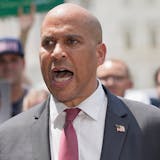There are more than 700,000 Americans living within a 68-square-mile area who have no elected representation in Congress. They are allowed to vote in presidential elections only for Electoral College electors, not the candidates themselves. Congress can and often does intervene in the local governance of this area.
This population is bigger than those of Vermont and Wyoming and just a bit smaller than those of Alaska and North Dakota. If you haven't guessed already, these Americans live in the District of Columbia.
There are no objections to D.C. statehood that outweigh lack of elected representation for hundreds of thousands of America citizens.
D.C. residents have long sought statehood. Some like Eleanor Holmes Norton, the district's nonvoting representative in Congress, have made it their life's work. For every one of the past 14 years she has introduced a bill to grant statehood to the district. (Holmes Norton, by the way, is allowed to sit in the House and vote in committee only. So toothless is her position that she was not permitted a floor vote on her own bill.) This time, it actually passed the House with more than 200 cosponsors, and President Joe Biden has said he will sign it if it comes to his desk.
That leaves only the Senate, where the most cynical of all objections comes from Minority Leader Mitch McConnell, who has declared that because such a move might benefit Democrats with two more senators, he will block it. The fact is, statehood has long been partisan in nature. A recent article from the Atlantic shows that late-19th-century Republicans favored adding states as a strategy that would keep them in power. In just two years, between 1889 and 1890, Congress added Idaho, Montana, North Dakota, South Dakota, Washington and Wyoming. In fact, that strategy is the reason we have two Dakotas. The Historical Society of North Dakota, as part of its school teaching guide, notes that "the Republican Party, which wanted more power in the U.S. Senate, put pressure to divide Dakota into two states."
U.S. Sen. Tina Smith, D-Minn., told an editorial writer that the arguments against D.C. statehood "sort of fall away when you look at them." Constitutional concerns, she said, are easily addressed by shrinking the federal district to a size that just encompasses the White House and federal buildings, not a land mass home to more than 700,000.
The district, originally 100 square miles of land donated by Virginia and Maryland, shrunk to 68 miles in the 1800s, with the Virginia portion returned to that state out of disenfranchisement concerns. Maryland, it should be noted, does not want to absorb D.C. Neither do D.C. residents want to become part of Maryland.
"The district has an identity all its own," Smith said. "To join them up with another state has the practical effect of diluting their voices, their issues." Among Smith's concerns is not only the fundamentally undemocratic denial of full citizenship rights for district residents but the fact that, historically, blacks have made up close to a majority of the population.



